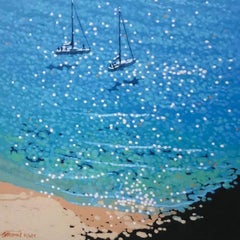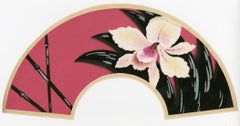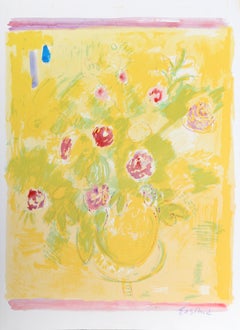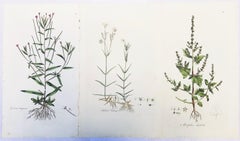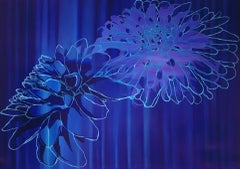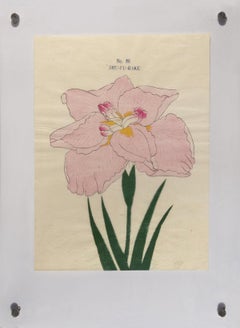Paint Still-life Prints
to
24
43
54
22
16
8
Overall Width
to
Overall Height
to
32
7
6
6
4
3
3
1
11
10
10
8
8
31
23
29
60
4
1
1
6
4
3
27
97
30
15
62
47
31
23
21
15
15
12
11
9
8
8
6
6
6
6
6
5
5
4
202,758
1,397
985
613
589
45
11
105
36
Medium: Paint
Anchored Up, Limited edition seascape, landsacpe, still-life, sailing
By Gordon Hunt
Located in Deddington, GB
Anchored Up By Gordon Hunt [2022]
limited_edition
Acrylic paint on paper
Edition number 20
Image size: H:50 cm x W:50 cm
Complete Size of Unframed Work: H:60 cm x W:60 cm x D:0.5...
Category
21st Century and Contemporary Contemporary Paint Still-life Prints
Materials
Acrylic
Orchid and Bamboo (Sensu-e)
Located in Fairlawn, OH
Japanese (mid 20th Century)
Unsigned wood cut with hand embellishments in gouache created for a Japanese folding fan.
Unsigned
Image size: 8 3/8 x 18 1/8 inches
Mounted on support sh...
Category
Mid-20th Century Other Art Style Paint Still-life Prints
Materials
Gouache
Quiet Sunday (Yellow), Modern Hand-painted Lithograph by Wayne Ensrud
By Wayne Ensrud
Located in Long Island City, NY
A unique hand-painted lithograph of a colorful Bouquet of Flowers by Wayne Ensrud, American (1934).
Quiet Sunday (Yellow)
Wayne Ensrud, American (1934)
Date: 1980
Hand-Painted Lithog...
Category
1980s Contemporary Paint Still-life Prints
Materials
Lithograph, Acrylic
Set of Three Engravings from Curtis's "Flora Londinensis" /// Botanical Flowers
Located in Saint Augustine, FL
Artist: William Curtis (English, 1746-1799)
Titles: "Epilobium Tetragonum (Square Stalked Willow Herb)" (Vol. 2, Plate 131), "Stellaria Holostea (The Greater Stitchwort)" Vol. 2, Pla...
Category
1770s Old Masters Paint Still-life Prints
Materials
Watercolor, Laid Paper, Engraving, Intaglio
Dahlia Blue, Contemporary Art, Floral Art, Colourful Print, Statement Art
Located in Deddington, GB
Oil on aluminium bespoke commission. A statment floral piece to be the focal point of any large wall.
Helen Brough paintings available at Wychwood Art online and in the gallery. Hel...
Category
21st Century and Contemporary Contemporary Paint Still-life Prints
Materials
Metal
Iris Kaempferi: No. 58 SHU-FU-RAKU
Located in London, GB
Iris Kaempferi: No. 58 SHU-FU-RAKU
Tokyo, Yoshinoen-Garden, circa 1910.
Hand-coloured woodblock print on handmade rice paper, numbered and captioned at top, outlined in ink. Framed...
Category
1910s Naturalistic Paint Still-life Prints
Materials
Wood, Watercolor, Rice Paper
Cyrilla Pulchella Scarlet-Flowered Cyrilla /// English Botanical Flower Print
Located in Saint Augustine, FL
Artist: William Curtis (English, 1746-1799)
Title: "Cyrilla Pulchella Scarlet-Flowered Cyrilla" (Vol. 11, Plate 374)
Portfolio: The Botanical Magazine; or, Flower-Garden Displayed
Ye...
Category
1790s Victorian Paint Still-life Prints
Materials
Watercolor, Engraving, Intaglio
Green Wicker Chair
Located in New York, NY
Still Life depicting a green wicker chair. Signed by the artist in the lower left corner.
Jean Hannon grew up in Boston and attended the School at ...
Category
Late 20th Century Post-Impressionist Paint Still-life Prints
Materials
Canvas, Oil
Set of Two Hand-Colored Lithographs from Roscoe's "Monandrian Plants" /// Botany
Located in Saint Augustine, FL
Artist: William Roscoe (English, 1753-1831)
Title: "Maranta Arundinacea (Arrowroot)" and "Phrynium Grandiflorum"
Portfolio: Monandrian Plants of the order Scitamineae, Chiefly Drawn ...
Category
1820s Victorian Paint Still-life Prints
Materials
Watercolor, Lithograph
Set of Three Hand-Colored Lithographs from Roscoe's "Monandrian Plants"
Located in Saint Augustine, FL
Artist: William Roscoe (English, 1753-1831)
Title: "Phrynium Myrosma", "Costus Maculatus", and "Kaempferia Galanga (Aromatic Ginger)"
Portfolio: Monandrian Plants of the order Scitam...
Category
1820s Victorian Paint Still-life Prints
Materials
Watercolor, Lithograph
Set of Two Hand-Colored Lithographs from Roscoe's "Monandrian Plants" /// Botany
Located in Saint Augustine, FL
Artist: William Roscoe (English, 1753-1831)
Titles: "Hedychium Glaucum" and "Zingiber Elatum"
Portfolio: Monandrian Plants of the order Scitamineae, Chiefly Drawn from Living Specime...
Category
1820s Victorian Paint Still-life Prints
Materials
Watercolor, Lithograph
Glaucium Phoenicium (Red Horned-Poppy) /// James Sowerby Botanical Flower Plant
Located in Saint Augustine, FL
Artist: James Sowerby (English, 1757-1822)
Title: "Glaucium Phoenicium (Red Horned-Poppy)" (Vol. 7, Plate 1433)
Portfolio: English Botany; or, Coloured Figures of British Plants
Year...
Category
Early 1800s Victorian Paint Still-life Prints
Materials
Watercolor, Engraving, Intaglio
Jasminum officinale (Common jasmine) /// Pierre-Joseph Redouté Botanical Flower
Located in Saint Augustine, FL
Artist: (after) Pierre-Joseph Redouté (French, 1759-1840)
Title: "Jasminum officinale (Common jasmine)" (No. 27 page 93)
Portfolio: Traité des Arbres et Arbustes que l'on Cultive en ...
Category
Early 1800s Old Masters Paint Still-life Prints
Materials
Watercolor, Engraving
Atraphaxis (Shrub); Cabomba (Carolina Fanwort) /// Botanical Botany Plants Art
Located in Saint Augustine, FL
Artist: Georges-Louis Leclerc, Comte de Buffon (French, 1707-1788)
Title: "Atraphaxis (Shrub); Cabomba (Carolina Fanwort)" (Hexandrie, Digynie, Plate 265)
Portfolio: Histoire Naturel...
Category
1740s Naturalistic Paint Still-life Prints
Materials
Watercolor, Engraving, Laid Paper, Intaglio
Cosovo No 1
By Kim Frohsin
Located in Burlingame, CA
Girl's shoes, heels or tap shoes in bronze, black and gold, featured in this Monotype ev edition 8/8 with hand coloring. Kim Frohsin spent 12 years working o...
Category
1990s Contemporary Paint Still-life Prints
Materials
Gouache, Mixed Media, Monotype, Pastel
Bottles No 2
By Kim Frohsin
Located in Burlingame, CA
Monotype ev edition 5/6 with hand coloring. the overall paper size is 23 1/2 x 23 inches. Kim Frohsin spend 12 years making monotype ev's, and works from this series are included in ...
Category
21st Century and Contemporary Contemporary Paint Still-life Prints
Materials
Gouache, Mixed Media, Monotype, Pastel
Limited Edition Sublimation Print on Silk - 2nd from the Diptych - Flowers
Located in Vilnius, Vilniaus apskr.
This contemporary artwork, crafted using a sublimation process, offers an exquisite transfer of vivid imagery onto silk through eco-friendly, water-based sublimation inks.
Its hybr...
Category
2010s Contemporary Paint Still-life Prints
Materials
Silver
Dried Flowers in a Stoneware Vase giclee print spring color gift decor mom
By Kevin Knopp
Located in Milwaukee, WI
This giclee print on canvas is hand embellished with acrylic gel brushstrokes after the 2001 original oil painting. Depicting brightly colored flowers in a vase, this beautiful artwo...
Category
2010s Contemporary Paint Still-life Prints
Materials
Canvas, Acrylic, Giclée
Spoon to Shell 818 - Mixed Media Shell Wood Contemporary Assemblage Sculpture
Located in New York, NY
Linda Stein, Spoon to Shell 818 - Mixed Media Shell Wood Contemporary Assemblage Sculpture
Spoon to Shell 818 is from Linda Stein's Holocaust Heroes: Fierce Females series, which hi...
Category
2010s Contemporary Paint Still-life Prints
Materials
Metal
Original 70's Hand Painted Textile Design Gouache Green Blue Color on Grey Pape
Located in ALCOY/ALCOI, ES
Flower bouquet design. Sealed on the back with the design studio name and number 484
We offer a small number of these original illustration designs by this design studio based in Al...
Category
1970s Modern Paint Still-life Prints
Materials
Paper, Gouache
Abolboda; Elodea (Waterweeds); Lepidosperma (Hoary Rapier-Sedge) /// Botanical
Located in Saint Augustine, FL
Artist: Georges-Louis Leclerc, Comte de Buffon (French, 1707-1788)
Title: "Abolboda; Elodea (Waterweeds); Lepidosperma (Hoary Rapier-Sedge)" (Triandrie Monogynie, Plate 905)
Portfoli...
Category
1740s Naturalistic Paint Still-life Prints
Materials
Watercolor, Engraving, Laid Paper, Intaglio
"Leaves & Berries" giclée print after ca. 1950s original watercolor and collage
Located in Milwaukee, WI
14.75 x 17.75 inches, artwork
22.88 x 25.75 inches, frame
Born in 1908, Sylvia Spicuzza was the daughter of noted painter Francesco Spicuzza. Sylvia devoted herself to teaching art ...
Category
1950s Modern Paint Still-life Prints
Materials
Giclée, Watercolor
Limited Edition Sublimation Print on Silk - 1st from the Diptych - Flowers
Located in Vilnius, Vilniaus apskr.
This contemporary artwork, crafted using a sublimation process, offers an exquisite transfer of vivid imagery onto silk through eco-friendly, water-based sublimation inks.
Its hybr...
Category
2010s Contemporary Paint Still-life Prints
Materials
Silver
Paint still-life prints for sale on 1stDibs.
Find a wide variety of authentic Paint still-life prints available on 1stDibs. While artists have worked in this medium across a range of time periods, art made with this material during the 21st Century is especially popular. If you’re looking to add still-life prints created with this material to introduce a provocative pop of color and texture to an otherwise neutral space in your home, the works available on 1stDibs include elements of blue and other colors. There are many well-known artists whose body of work includes ceramic sculptures. Popular artists on 1stDibs associated with pieces like this include Roger Crossgrove, Holly Downing, Bertha Evelyn Clausen Jaques, and Kind of Cyan. Frequently made by artists working in the Contemporary, Modern, all of these pieces for sale are unique and many will draw the attention of guests in your home. Not every interior allows for large Paint still-life prints, so small editions measuring 1.75 inches across are also available Prices for still-life prints made by famous or emerging artists can differ depending on medium, time period and other attributes. On 1stDibs, the price for these items starts at $33 and tops out at $46,790, while the average work can sell for $499.
Recently Viewed
View AllMore Ways To Browse
Mexican Boat Paintings
Michael Bergt
Michael Clement
Michael Daly
Michael Easton
Michael Eisemann
Michiel Schrijver
Mick Jagger Poster Vintage
Midcentury Beach Umbrella
Midwest Landscape Painting
Miguel Dominguez
Miles Davis Poster
Misty Loch
Mixed Media Trees Birds
Monarch Of The Glen
Monet Student
Morrow Oil
Mr Fish
